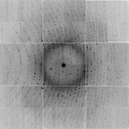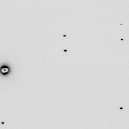

Once the transformations are complete, the 4-byte float file can be converted back into an "SMV" format image using noisify.
pre-compiled binaries: linux, OSX, Windows
there are no dependencies beyond the standard C math libraries shipped with essentailly all modern C compilers.
wget http://bl831.als.lbl.gov/~jamesh/bin_stuff/int2float.ccompile it
gcc -O -O -o int2float int2float.c -lmGet an SMV x-ray image here:
wget http://bl831.als.lbl.gov/example_data_sets/ALS/831/Gd_lyso1/ALS831_lyso_Gd_001.imgconvert the SMV image to floats

./int2float -header 512 ALS831_lyso_Gd_001.img smv.binuse the unix "od" utility to view the result:
od -f smv.bin | head 0000000 8.224000e+03 8.224000e+03 8.224000e+03 8.224000e+03 * 0000140 1.000000e+01 0.000000e+00 0.000000e+00 0.000000e+00 0000160 0.000000e+00 0.000000e+00 0.000000e+00 0.000000e+00 * 0060000 0.000000e+00 0.000000e+00 4.000000e+01 4.000000e+01 0060020 4.000000e+01 1.600000e+01 2.400000e+01 3.800000e+01 0060040 4.700000e+01 4.200000e+01 3.200000e+01 2.700000e+01 0060060 4.000000e+01 4.300000e+01 3.600000e+01 3.300000e+01 0060100 4.000000e+01 4.200000e+01 3.800000e+01 3.400000e+01compare this with the pixel values you get from the original file:
od -t u2 --skip=512 ALS831_lyso_Gd_001.img | head 0001000 8224 8224 8224 8224 8224 8224 8224 8224 * 0001060 10 0 0 0 0 0 0 0 0001100 0 0 0 0 0 0 0 0 * 0031000 0 0 40 40 40 16 24 38 0031020 47 42 32 27 40 43 36 33 0031040 40 42 38 34 48 43 50 37 0031060 27 43 39 43 43 35 35 38 0031100 46 40 31 37 36 29 26 52Now you can do any number of things to the floating-point values using the float_add, float_mult, or float_func utilities. For example, you can convert the pixel values into photon counts. like this:
float_add smv.bin smv.bin -scale1 0.625 -scale2 0 -offset 40 -outoffset 0 photons.bin od -f photons.bin | head 0000000 4546.212 4546.212 4546.212 4546.212 * 0000140 -16.664999 -22.22 -22.22 -22.22 0000160 -22.22 -22.22 -22.22 -22.22 * 0060000 -22.22 -22.22 0 0 0060020 0 -13.331999 -8.888 -1.111 0060040 3.8884997 1.111 -4.444 -7.2214994 0060060 0 1.6664999 -2.222 -3.8884997 0060100 0 1.111 -1.111 -3.3329997Notice that the photon "counts" are not integers. This is normal. We are correcting for a "detector gain" of 1.6 by multiplying the pixel values by 0.625, after subtracting the "ADC offset" of 40.
Depending on wavelength, angle, and other factors the signal recorded by the detector from a single photon hit can vary, and in general the value recorded in the image file is related to the photon count by a scale factor called the "gain" and an offset called the "adc offset". These are the same gain and adc offset you need to provide to data processing programs if they are not set correctly by default.
In this case, we are using a gain of 1.6 ADU/photon and an offset of 40 ADU. Where "ADU" is an "Area Detector Unit", or the signal required to increment the integer value stored in the image file by one tick.
Although often incorrectly referred to as "counts" one ADU does not necessarily mean one X-ray photon. The "gain" in ADU/photon depends not only on the sensitivity of the detector (which varies with wavelength, incidence angle, and other factors), but also on the choice of binning mode, and the setting of the amplifier before the analog-to-digital converter (ADC). Because of this, the gain has little to do with the "quality" of the detector, but it is still important to give the right value to your data processing package.
The pixel values also contain an offset: 40 ADU in this case. This is because the CCD read-out circuit always introduces a certain amount of noise and this noise is equally likely to be positive or negative, but the "unsigned integer" data type used in the image file cannot represent a negative value, it would "wrap around" and become an overload! To keep this from happening, a small constant value is added to ever pixel: the ADC offset. It is large enough to garantee the value cannot go negative, but small enough not to use up too much of the 16 bit dynamic range. The CCD read-out noise level here is about rms 3 pixel levels (aka ADU), so an offset of 40 is safe.
So, when you see a value of 40 "counts" in an ADSC image, it is really representing zero photons.
So, we could round off the photons to integers, but that would introduce roundoff error, adding noise to the data. Yes, the original digitization of the signal from the CCD also introduced roundoff error, but there is nothing we can do about that now. Fortunately, by selecting a "gain" greater than one the roundoff error is kept much smaller than the photon-counting error.
Now let's convert the photon counts back into an SMV file using noisify:
wget http://bl831.als.lbl.gov/~jamesh/bin_stuff/noisify.c gcc -o noisify noisify.c -lm ./noisify -floatfile photons.bin -nonoise -gain 1.6 -adc 40.5 -header ALS831_lyso_Gd_001.img -intfile intimage.img adxv intimage.imgThe SMV-format image output in this way should be byte-for-byte identical to the original SMV-format image input into int2float. The reason for using an ADC offset of 40.5 instead of 40 is because noisify internally rounds all photon counts into integers.
